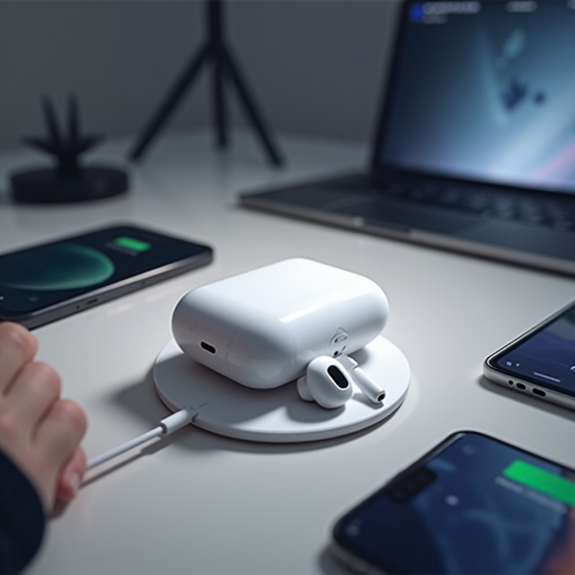Finding the perfect audiophile headphones requires understanding your unique listening preferences and needs. Selecting headphones involves knowing different features that impact sound quality and user experience. This guide illuminates key aspects to consider, helping you make an informed decision. Whether you’re an audiophile seeking perfection or a newcomer wanting to upgrade your listening experience, understanding these features will guide you to your ideal headphones.

What Are Audiophile Headphones and Who Are They For?
Definition and Purpose
Audiophile headphones are designed to deliver high-fidelity audio, offering a more accurate reproduction of the original recording. They prioritize sound quality above features like noise cancellation or wireless connectivity. These headphones are crafted for those who value audio purity and wish to experience music with minimal distortion. Audiophile-grade models often feature premium components, refined acoustic engineering, and meticulous tuning. These features ensure that the audio output remains faithful to the studio master, making them ideal for dedicated listeners who crave the finest sonic detail in every listening session.
Casual Listeners vs. Audiophiles
Casual listeners typically prioritize convenience and versatility, often opting for headphones with user-friendly features. Audiophiles, however, seek a deeply immersive listening experience. They analyze every note and nuance, often using high-quality audio sources to maximize their headphones’ capabilities. If you aspire to hear music as the artist intended, audiophile headphones are your match. Audiophiles also tend to research sound signatures, component compatibility, and even cable materials. This pursuit is driven by a passion for accurate reproduction and emotional connection to music, elevating listening from a pastime to an art.
How to Choose the Right Audiophile Headphones?
Open-Back vs. Closed-Back Designs
The design affects sound quality and isolation. Open-back headphones offer a natural, airy sound stage, ideal for home use. Closed-back designs provide better sound isolation, suitable for noisy environments but can compromise the soundstage. Open-backs are preferred for analytical listening and studio mixing, allowing sound to flow freely for an immersive feel. In contrast, closed-backs are great for travel and casual environments where external noise interference could hinder enjoyment. Each type presents unique strengths depending on the listening context and your desired balance between immersion and isolation.
Impedance and Sensitivity Explained
Understanding impedance (measured in Ohms) and sensitivity affects how headphones work with different audio sources. High-impedance models often require amplifiers to deliver optimal sound levels, while low impedance options are more suitable for everyday devices. Sensitivity measures how loud headphones can get given a power level. Together, impedance and sensitivity dictate the compatibility and performance of headphones with smartphones, DACs, or professional studio gear. Knowing these specifications ensures you pair your headphones with the right equipment for consistent, distortion-free audio performance across a wide dynamic range.
Wired vs. Wireless: Which Is Better for Audiophiles?
Wired headphones are favored by purists for their consistent and uncompressed sound quality. While wireless technology has improved, wired connections minimize lag and audio deterioration, crucial for audiophiles. Latency and compression in wireless setups may not meet the strict fidelity standards sought by audio enthusiasts. Audiophile-grade wired headphones often include detachable cables with balanced connectors to reduce signal interference. While convenience is a benefit of wireless headphones, the commitment to transparency and fidelity often makes wired models the preferred choice for critical, high-resolution listening sessions at home or in studios.
Comfort, Build, and Material Considerations
Invest in headphones with quality build materials that offer durability and comfort for long listening sessions. Materials like memory foam ear pads and adjustable headbands enhance usability, making a significant difference during extended use. Lightweight frames, breathable fabrics, and swiveling ear cups reduce fatigue during multi-hour listening. Premium materials such as leather, aluminum, or magnesium alloys contribute to both longevity and a premium feel. Beyond aesthetics, these materials also help improve acoustic properties by reducing unwanted vibrations and resonance, making your investment both physically and sonically comfortable over time.

Which Audio Specs Really Matter?
Frequency Response Range
This range indicates the spectrum of audio frequencies headphones can reproduce. Most models cover 20Hz to 20kHz, the human hearing range, but some expand beyond for richer audio textures, appealing to those who appreciate deep bass and crisp highs. Extended ranges can improve headroom and overall sound realism, especially in genres that exploit high-frequency harmonics or low sub-bass. While not always perceivable, these extended frequencies can subtly enhance the depth and spaciousness of recordings. It's important to also consider how well the headphones actually perform within this stated frequency range.
Driver Types and Their Impact on Sound
Drivers, the components converting electrical signals into sound, come in various types like dynamic, planar magnetic, and electrostatic. Each type has distinct sound characteristics that impact audio precision and clarity. Dynamic drivers are common and offer good bass response, while planar magnetic drivers deliver exceptional detail and lower distortion. Electrostatic drivers provide unrivaled clarity and speed, often found in high-end headphones. The construction, size, and technology behind each driver greatly influence the listening experience, so understanding the strengths and weaknesses of each can help you choose the best option for your preferences.
Total Harmonic Distortion and Soundstage
Seek headphones with low total harmonic distortion (THD) for cleaner sound and minimal distortion at high volumes. A well-defined soundstage helps position instruments accurately, enhancing immersion. THD below 1% is ideal, especially at louder volumes where distortion can degrade clarity. A wide and deep soundstage can create the illusion of a live performance, particularly valuable for genres like classical, jazz, or live acoustic recordings. Headphones that excel in this area often use open-back designs and premium drivers, which together provide an expansive audio environment that feels lifelike and emotionally engaging.
What’s Your Source and Setup?
DACs and Amps: Do You Need Them?
DACs (Digital-to-Analog Converters) and amplifiers can significantly improve sound quality. High-impedance headphones often require amplification, while DACs enhance digital audio sources, giving listeners a richer experience. A dedicated DAC bypasses lower-quality built-in converters in phones or laptops, providing cleaner signal conversion. Amplifiers offer more power and dynamic control, especially important for headphones that demand higher voltage. Together, these components unlock the full potential of audiophile headphones by delivering clarity, detail, and depth. Investing in quality source gear ensures your headphones perform optimally and reveal the subtle nuances in your favorite tracks.
Matching Headphones to Your Audio Equipment
Ensure your headphones complement your current setup. This involves compatibility with your DAC, amp, or portable player, maximizing their performance. Matching impedance levels and output power ensures neither distortion nor underperformance. For instance, using high-impedance headphones with a weak source will result in low volume and thin sound. Balanced cables can reduce interference and improve stereo separation. Always check your equipment’s specifications to guarantee optimal synergy. Thoughtful matching enhances soundstage, detail retrieval, and overall fidelity, creating a harmonious audio chain that transforms your listening experience from functional to truly high-end.
Hi-Res Audio Files vs. Streaming Quality
Audiophiles often prefer high-resolution audio files over standard streaming quality for their superior sound experience. Ensure your headphones support high-res audio to capture subtle details in these files. Lossless formats like FLAC or ALAC retain full audio quality, unlike MP3s which compress data and reduce fidelity. Some streaming platforms now offer Hi-Res tiers, but device and headphone support are key for fully appreciating these formats. Listening to high-res audio on capable headphones reveals extended harmonics, broader dynamics, and greater emotional depth—critical factors for those who aim to experience music in its purest form.
Conclusion
Choosing Audiophile Headphones involves understanding various technical aspects and personal preferences. By assessing critical features like design, impedance, frequency response, and setup integration, you can elevate your listening experience. Equip yourself with these insights to find headphones that transcend casual listening. As you explore different models, prioritize those that align with your music taste and listening environment. Don’t overlook factors like long-term comfort, upgradeability, and brand reputation. With the right research and investment, your journey into audiophile sound can be both rewarding and transformative, turning everyday music into a deeply immersive experience.
FAQ
Are audiophile headphones good for gaming or movies?
Yes, for those seeking high-fidelity sound in gaming or films, audiophile headphones provide exceptional detail and soundstage, increasing immersion.
Can my phone drive high-impedance headphones?
Phones often struggle with high-impedance headphones. Consider using an external amp to achieve adequate sound levels and quality.
What’s the best price range for entry-level audiophile headphones?
For beginners, investing between $150 and $300 can yield excellent quality without overwhelming complexity, offering a taste of high-fidelity sound.
